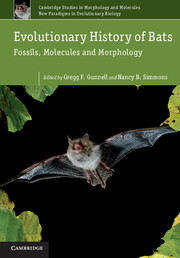Book contents
- Frontmatter
- Contents
- Contributors
- Preface
- 1 Phylogenies, fossils and functional genes: the evolution of echolocation in bats
- 2 Systematics and paleobiogeography of early bats
- 3 Shoulder joint and inner ear of Tachypteron franzeni, an emballonurid bat from the Middle Eocene of Messel
- 4 Evolutionary history of the Neotropical Chiroptera: the fossil record
- 5 New basal noctilionoid bats (Mammalia: Chiroptera) from the Oligocene of subtropical North America
- 6 Necromantis Weithofer, 1887, large carnivorous Middle and Late Eocene bats from the French Quercy Phosphorites: new data and unresolved relationships
- 7 African Vespertilionoidea (Chiroptera) and the antiquity of Myotinae
- 8 Evolutionary and ecological correlates of population genetic structure in bats
- 9 A bird? A plane? No, it's a bat: an introduction to the biomechanics of bat flight
- 10 Toward an integrative theory on the origin of bat flight
- 11 Molecular time scale of diversification of feeding strategy and morphology in New World Leaf-Nosed Bats (Phyllostomidae): a phylogenetic perspective
- 12 Why tribosphenic? On variation and constraint in developmental dynamics of chiropteran molars*
- 13 Necromantodonty, the primitive condition of lower molars among bats
- 14 Echolocation, evo-devo and the evolution of bat crania
- 15 Vertebral fusion in bats: phylogenetic patterns and functional relationships
- 16 Early evolution of body size in bats
- Index
- Plate section
- References
11 - Molecular time scale of diversification of feeding strategy and morphology in New World Leaf-Nosed Bats (Phyllostomidae): a phylogenetic perspective
Published online by Cambridge University Press: 05 June 2012
- Frontmatter
- Contents
- Contributors
- Preface
- 1 Phylogenies, fossils and functional genes: the evolution of echolocation in bats
- 2 Systematics and paleobiogeography of early bats
- 3 Shoulder joint and inner ear of Tachypteron franzeni, an emballonurid bat from the Middle Eocene of Messel
- 4 Evolutionary history of the Neotropical Chiroptera: the fossil record
- 5 New basal noctilionoid bats (Mammalia: Chiroptera) from the Oligocene of subtropical North America
- 6 Necromantis Weithofer, 1887, large carnivorous Middle and Late Eocene bats from the French Quercy Phosphorites: new data and unresolved relationships
- 7 African Vespertilionoidea (Chiroptera) and the antiquity of Myotinae
- 8 Evolutionary and ecological correlates of population genetic structure in bats
- 9 A bird? A plane? No, it's a bat: an introduction to the biomechanics of bat flight
- 10 Toward an integrative theory on the origin of bat flight
- 11 Molecular time scale of diversification of feeding strategy and morphology in New World Leaf-Nosed Bats (Phyllostomidae): a phylogenetic perspective
- 12 Why tribosphenic? On variation and constraint in developmental dynamics of chiropteran molars*
- 13 Necromantodonty, the primitive condition of lower molars among bats
- 14 Echolocation, evo-devo and the evolution of bat crania
- 15 Vertebral fusion in bats: phylogenetic patterns and functional relationships
- 16 Early evolution of body size in bats
- Index
- Plate section
- References
Summary
Introduction
Diversification of feeding strategies within each of the 19 chiropteran families (Hoofer and Van Den Bussche, 2003; Van Den Bussche and Hoofer, 2004; Simmons, 2005) typically is limited to one (13 families) or two (five families) food sources. The family Phyllostomidae, however, represents an exception to this pattern with six distinct feeding strategies: sanguivory, insectivory, frugivory, nectivory, carnivory (feeding on vertebrates) and omnivory.
Among families of bats, phyllostomids comprise the largest number of genera (56) and the third largest number of species (160+) (Simmons, 2005). They are distributed throughout tropical and subtropical regions of North and South America and have been highly successful in exploiting a diverse array of life-history strategies. Included among its members are three species of obligate sanguivores, a feeding strategy unknown in vertebrates other than fish (Figure 11.1). Among phyllostomids additional examples of feeding specialization exist, including subsisting exclusively on insects, as well as primarily on fruit, nectar, frogs, rodents and other vertebrates. Such specializations are remarkable when viewed in the context of the concomitant suite of adaptations associated with the sensory apparatus, locomotion, digestion, dentition, kidney function and reproduction, among others (Griffiths, 1982; Greenhall and Schmidt, 1988: Fleming et al., 2005) that must be favored by directional natural selection for successful exploitation of new ecological opportunities. No other clade of mammals with roots in the Eocene displays such radical evolutionary modifications.
- Type
- Chapter
- Information
- Evolutionary History of BatsFossils, Molecules and Morphology, pp. 385 - 409Publisher: Cambridge University PressPrint publication year: 2012
References
- 51
- Cited by



